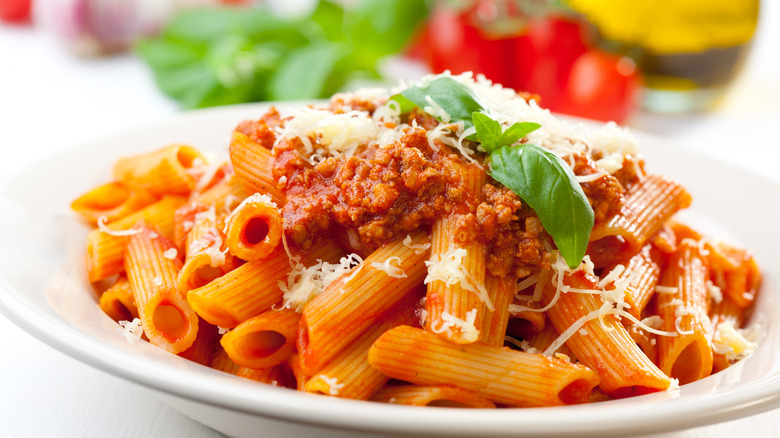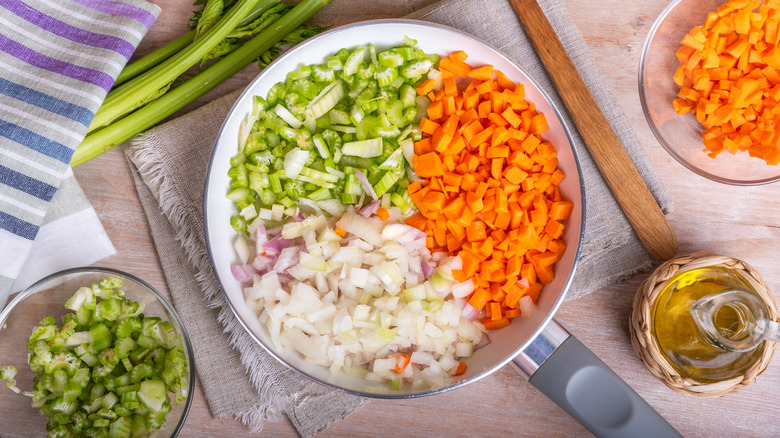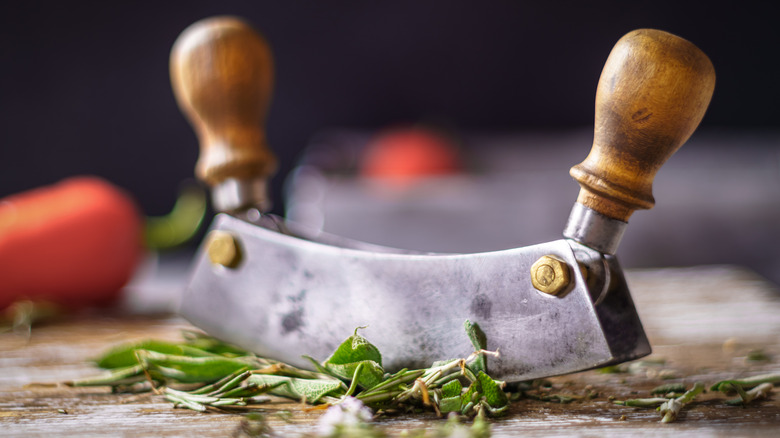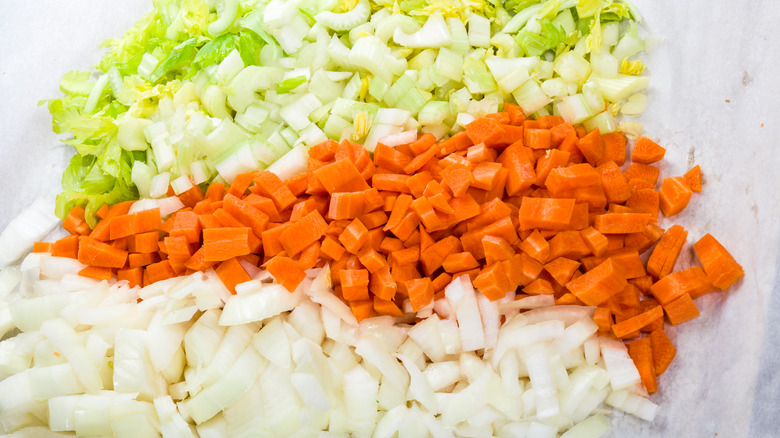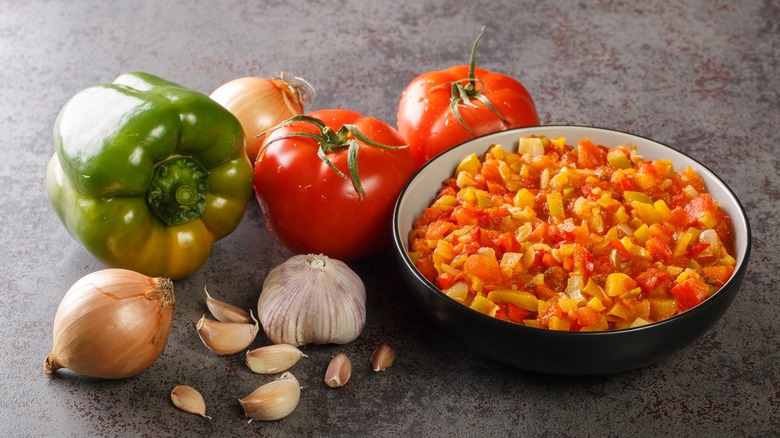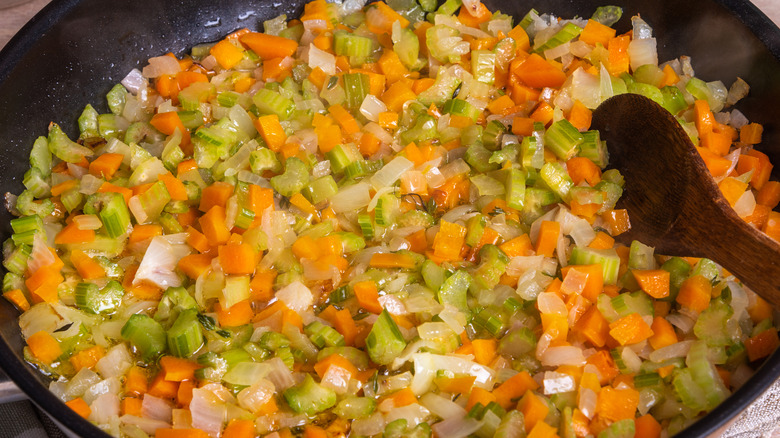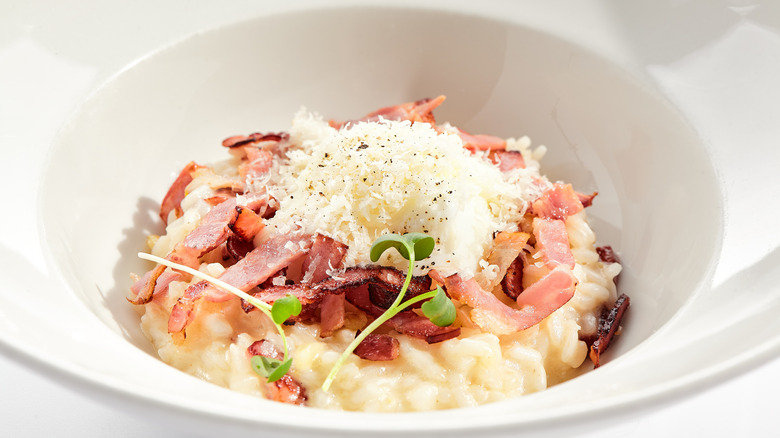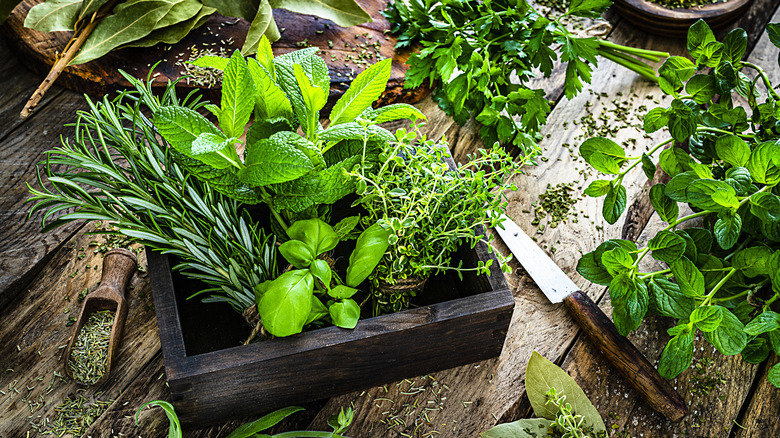What Is Soffritto And How Do You Make It?
Italian cuisine is often known for its paired-back, restrained, yet intentional choices. Less is considered more. If you're just beginning to dip a toe into cooking Italian food at home, consider investing in a few good quality ingredients. Paired with the right seasonings, flavors will shine through whatever dish you make, creating a satisfying and flavorful meal you'll want to make again and again.
There are a few humble but extraordinary culinary stars of Italian cuisine known for their ability to transform a dish from good to excellent. While these may differ slightly based on region, soffritto is one such star embraced nationwide. It's the silent, study backbone, an understated but essential base for many Italian dishes we have come to know and love.
Want to know why your risotto so was so spectacular? It's likely a combination of good quality arborio rice cooked in a soffritto that gave the dish its depth of flavor. What made that bolognese so unforgettable? Again, soffritto is the secret sauce. Here's what makes soffritto — and how you can prepare it at home to elevate your next foray into Italian cuisine.
What is soffritto?
Soffritto is a mixture of minced onion, carrot, and celery, gently fried in olive oil until soft and fragrant. Soffritto means "fried slowly."Much like the cuisine, the Italian language often cuts straight to the point. Soffritto is also referred to as battuto, which means "to beat down."
While the base of most Italian soffritto is made up of onion, carrot, and celery, other aromatics can be added, often based on regional traditions or the intended dish. By slowly and gently frying the mixture of vegetables, the low heat and copious amounts of olive oil encourage each element to release its natural flavors, which are used then as a base from which to build even more depth of flavor. Soffrittos are often used as a base for slow-cooked dishes, including stews, soups, and sauces. It is sometimes referred to by chefs as the "holy trinity," a term that can apply to many different base flavor combinations across various cuisines.
How important is soffritto in Italian cuisine?
How vital is soffritto in Italian cuisine? In short, very. Just like you cannot have a sturdy, well-built house without laying down a foundation, you can't have a delicious bowl of risotto, minestrone, or many other slow-cooked Italian dishes without first laying down a soffritto. When chefs refer to the mixture of carrot, onion, and celery as the "holy trinity" or "cornerstone" of Italian cuisine, they're not being overly dramatic. It's simply a fact and often one of the first techniques taught when learning about Italian cuisine, no matter the region.
As chef Erica De Mane writes in a blog post on soffritto, "I never heard of the word soffritto when I was growing up, but I knew the aroma. Whenever my mother started a tomato sauce or a ragù, I was aware of a deep, sweet essence of vegetable wafting through the kitchen ... the underpinning of just about every well-made Italian soup, braise, or sauce."
How is soffritto made?
The answer to this question might vary slightly, depending on how traditional you intend to be. Fundamentally, however, the ratio you'll want to consider to create a balanced mix of all three vegetables is two parts onion, one part carrot, and one part celery. This combination works if you're just making enough soffritto for one dish or if you intend to make a larger batch; perfect for portioning out and freezing individually.
Whatever size you intend to make, it is imperative to cut your vegetables into same-sized pieces; ideally, the smaller, the better for quicker cooking. This can be done with the press of a button in a food processor, by hand with a sharp knife, or by using a traditional Italian tool known as a mezzaluna. You may recognize this tool from its curved shape and double-sized handles, allowing for quick rocking-meets-chopping motion that can feel soothing once mastered.
Once cut to your desired size, it's time to fry. Using a heavy-bottomed pan or skillet and a generous amount of olive oil, gently heat the oil, then cook vegetables for as little as five minutes for a lighter-tasting mix or as long as 25 minutes for more depth of flavor. Whichever you choose, keep vegetables soft and caramelized rather than crispy. In some regions of Italy, a little bit of butter can also be added to the olive oil.
Soffritto versus mirepoix
Soffritto is to Italian cuisine as mirepoix is to French food. They are both culinary foundations, highly versatile and adaptive, and equally crucial to master if you want to create exceptional dishes from either cuisine.
While some might argue that these base aromatic building blocks are interchangeable, there are subtle yet substantial differences. The most obvious is that traditionally soffritto is made using olive oil, with butter added only in some regions of the country. Conversely, mirepoix is often cooked in butter or a mixture of butter and olive oil.
Other differences include the size of the vegetables, as mirepoix is often a small dice, whereas soffritto is a smaller mince-like size. For mirepoix, diced, gently cooked vegetables are often scooped out at the very end of a dish — it's meant to infuse flavor but not texture, as in broth and consomme. Whereas a soffritto, by comparison, is usually kept in the dish. Mirepoix vegetables are cooked low enough to become soft but do not pick up any color; this is also not the case for soffritto, which often takes on a golden, caramelized color if cooked for longer.
Soffritto versus sofrito
Though these two words are pronounced in the same way and are spelled in a very similar manner, make no mistake, they're different and should be treated as such. Soffritto comes from Italian cuisine, while sofrito, spelled with just one 'f' and one 't,' is Spanish. Not only do spellings differ, but ingredients do too!
The Italian soffritto combines carrot, onion, and celery, which have been finely minced and gently fried together in oil to create an aromatic base for many different dishes. Spanish sofrito, on the other hand, varies from region to region yet often combines onions, garlic, and tomato (regularly in the form of a paste). The results, you can imagine, are very different, as are their uses.
Sofrito is often used as a sauce, base, or filling with other ingredients like peppers, herbs, and spices. It often appears in a sauce over a paella or as a filling tucked into a delicious empanada. When poured over fried eggs, it can also make for a simple but delicious meal.
How to cook with soffritto
Once you begin cooking and using soffritto in your Italian dishes, the better question might be, "How did I ever not cook with soffritto?" Whatever dish you make, it may be helpful to think of the mixture of onion, carrot, and celery as a foundation for whatever comes next. Whether you're cooking it just for five minutes to impart a lighter and more subtle flavor or for twenty-five minutes for a richer, more caramelized seasoning, soffritto is where you start the dish rather than where it ends.
If you're preparing to cook Italian-leaning cuisine all week at home, you might want to make a big batch of soffritto at the beginning of the week. You can then save time by having it on hand to dip into each time the dinner hour rolls around. Alongside the vegetables you'll need, make sure to have plenty of good olive oil on hand for frying and any additional aromatics you might want to add, depending on what recipes you plan to make.
While it is often associated with slower cooking, like soups, sauces, and braises, soffritto also works well as a light sauce to compliment oily fish dishes, like fried sardines, popular within Mediterranean cuisine.
How to store soffritto
There are a few schools of thought when it comes to storing soffritto. The first involves chopping and prepping the raw vegetables, often referred to as the battuto, then keeping them covered in an airtight container in the fridge for no more than a day or two before use. If using this method, you'll want to store each ingredient separately. You can utilize the help of a paper towel in each container to help absorb unwanted moisture. You could also keep the components raw but freeze them and cook them straight from frozen. This approach keeps each batch of soffritto incredibly fresh and is often preferred among chefs.
However, much like batch cooking, you can also make a big pot of the stuff, cook it down until wonderfully caramelized, and then cool it completely before dividing it into individual portions and freezing. Each portion will last up to six months in the freezer (or five days in the fridge).
Recipes that use soffritto
Curious as to what recipes benefit from a base of soffritto? The short answer is most of them. Think anything slow-cooked, including stews, sauces, soups, and the quintessential and notoriously slow-cooked Italian classic, risotto.
To make a more flavorful risotto, first gently fry off your soffritto triad of onion, carrot, and celery, then add in your rice to quickly toast it, allowing it to begin to absorb the flavors of your aromatics before adding in your wine or stock.
Make a hearty minestrone by beginning the recipe with a soffritto (either made from fresh or one you've previously frozen). This recipe adds garlic to the usual mix of carrot, celery, and onion for an even richer and more flavorful taste. Once you've added the soffritto, you can begin to build flavors with potatoes, tomatoes, and herbs. Many of our favorite Italian pasta sauces, from bolognese to ragu, benefit from a soffritto. Want to take a lasagna from good to great? It's all about that sauce; it's the star of the show that brings the dish together. So, it's worth spending the extra time making sure it's as delicious as possible.
Ways you can change up or improve your next soffritto
If you've never made soffritto before, we'd encourage you to give it a try! When it comes to cooking skills, no matter how inexperienced you might be, everyone has to start. Plus, even if you're an experienced home cook, there is always room for improvement and innovation.
While there is no need to go beyond the three classic soffritto ingredients of onion, carrot, and celery if you don't wish, these base vegetables play very well with many other aromatics and ingredients, as is evident from their appearance in a range of cuisines. So, why not get a bit experimental in the kitchen and see what new combinations you can create and enjoy?
Garlic is a popular addition to the base flavor profile, as is pancetta, fresh, hearty herbs like rosemary, bay, and thyme, dried chili flakes, and tomato paste depending on what dish the soffritto is being used for. Delicate herbs like parsley and basil also make great additions but must be added towards the end of the cooking to keep from bruising and losing their flavor. You can also substitute the onion for leek, red onion, or shallots if that's what you have on hand.

